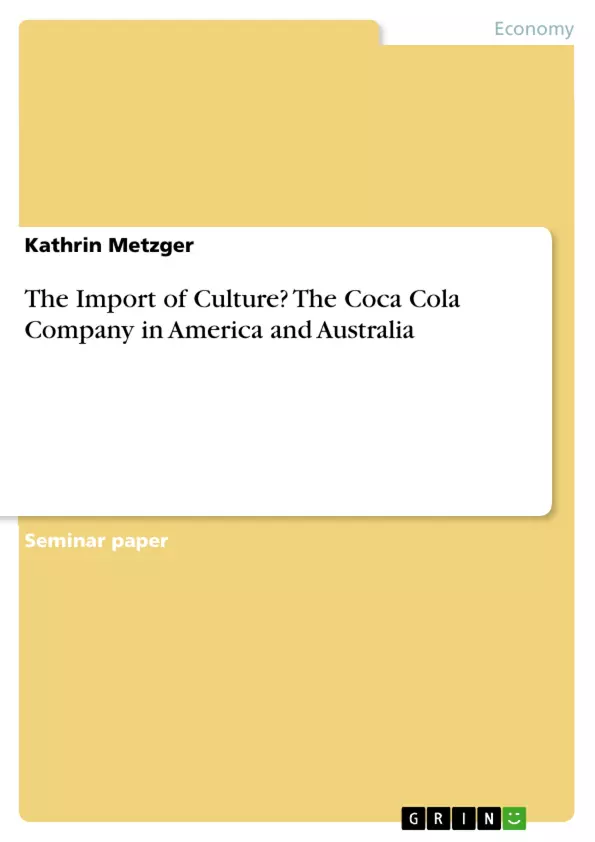This paper will look into how cultures and institutions still affect a company’s corporate governance and internal organization in their home country, but also determine whether this home country culture is then transferred onto their companies in host countries. It will also look into how both home and host country culture have an effect on a company’s choice of entry strategy. The subject of this paper is Coca Cola invented in 1886 in USA. The home country of The Coca-Cola Company (TCC) is therefore USA and the host country that we will be looking at in this paper is its bottling partner Coca-Cola Amatil Ltd. (CCA) in Australia.
Inhaltsverzeichnis (Table of Contents)
- Introduction
- Theories
- Hofstede's Culture Theory
- Corporate Governance
- Internal Organisation
- Entry Strategies
- Coca Cola Company USA
- Hofstede on USA
- Corporate Governance (CSR, Sustainability) of The Coca-Cola Company
- Internal Organisation of The Coca-Cola Company
- Cultural impact on Entry Strategies
- Coca Cola Amatil Ltd.
- Entry mode used in Australia
- Corporate governance
- Internal Organisation
- US Culture in Australia - was it successful?
- Impact of local culture and institutions on company
- Conclusion
Zielsetzung und Themenschwerpunkte (Objectives and Key Themes)
This paper examines how cultures and institutions influence a company's corporate governance and internal organization in its home country, and whether this home country culture is subsequently transferred to its operations in host countries. It further explores how both home and host country culture affect a company's choice of entry strategy. The paper focuses on the Coca-Cola Company, founded in 1886 in the USA, with a particular focus on its bottling partner Coca-Cola Amatil Ltd. in Australia.
- The influence of culture on corporate governance and internal organisation
- The impact of home country culture on a company's international operations
- The role of both home and host country cultures in entry strategy decisions
- The application of Hofstede's cultural dimensions to the Coca-Cola Company and its operations in Australia
- The relationship between corporate governance and a company's CSR and sustainability policies
Zusammenfassung der Kapitel (Chapter Summaries)
- Introduction: This chapter provides an overview of the paper's objectives and research focus, outlining the key themes of culture, corporate governance, and entry strategy. It introduces The Coca-Cola Company and Coca-Cola Amatil Ltd. as case studies.
- Theories: This chapter introduces Geert Hofstede's Culture Theory, outlining its core dimensions: power distance, individualism, masculinity, and uncertainty avoidance. It explains how these dimensions can be used to understand cultural differences between countries.
- Corporate Governance: This chapter delves into the concept of corporate governance, encompassing a company's ethics, CSR, and sustainability. It discusses the importance of these elements in both domestic and international business operations.
- Internal Organisation: This chapter explores various organizational structures that companies can adopt, including international division, geographic area, product, functional, and global matrix structures. It examines how the level of government intervention influences the choice of organizational structure.
- Entry Strategies: This chapter presents different ways companies can enter foreign markets, including exporting, joint ventures, and wholly owned subsidiaries. It emphasizes how cultural factors, particularly uncertainty avoidance, can influence the choice of entry mode.
- Coca Cola Company USA: This chapter examines the Coca-Cola Company's home country, the USA, through the lens of Hofstede's cultural dimensions. It highlights the USA's low power distance, high individualism, and moderate masculinity, as well as its relatively low uncertainty avoidance.
- Corporate Governance (CSR, Sustainability) of The Coca-Cola Company: This chapter analyzes the Coca-Cola Company's CSR and sustainability policies, highlighting its initiatives in areas such as sustainable packaging, water stewardship, and empowering women. It also addresses some controversies surrounding the company's environmental and social practices.
- Internal Organisation of The Coca-Cola Company: This chapter describes the Coca-Cola Company's internal organization, characterizing it as a global matrix structure. It explains how this structure allows for both geographic area and product-based operations, reflecting the low level of government intervention in the American economy.
- Cultural impact on Entry Strategies: This chapter examines how the Coca-Cola Company's cultural context influenced its choice of entry strategy, focusing on its use of franchising through bottling partners. It discusses how the USA's relatively low uncertainty avoidance may have contributed to this decision.
- Coca Cola Amatil Ltd.: This chapter focuses on Coca-Cola Amatil Ltd., the Coca-Cola Company's bottling partner in Australia. It explores the entry mode used by Coca-Cola in Australia, the company's corporate governance and internal organization, and the impact of the local culture on the company's operations.
Schlüsselwörter (Keywords)
This paper examines the impact of culture on corporate governance, internal organization, and entry strategy, focusing on the Coca-Cola Company and its bottling partner Coca-Cola Amatil Ltd. Key concepts include Hofstede's cultural dimensions, corporate social responsibility, sustainability, organizational structures, entry modes, and the influence of both home and host country cultures on multinational operations.
- Citar trabajo
- Kathrin Metzger (Autor), 2014, The Import of Culture? The Coca Cola Company in America and Australia, Múnich, GRIN Verlag, https://www.grin.com/document/283541



